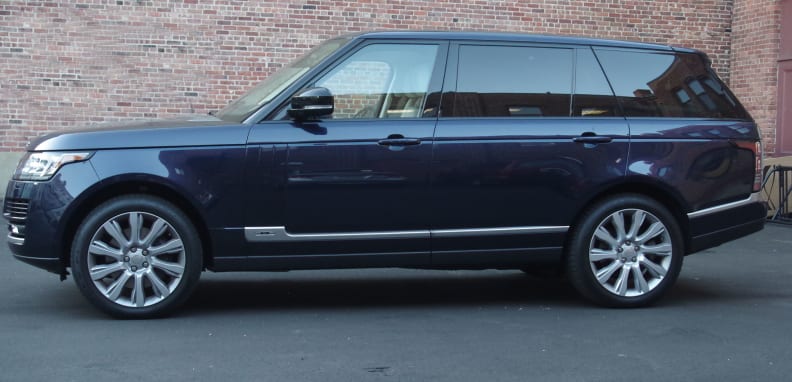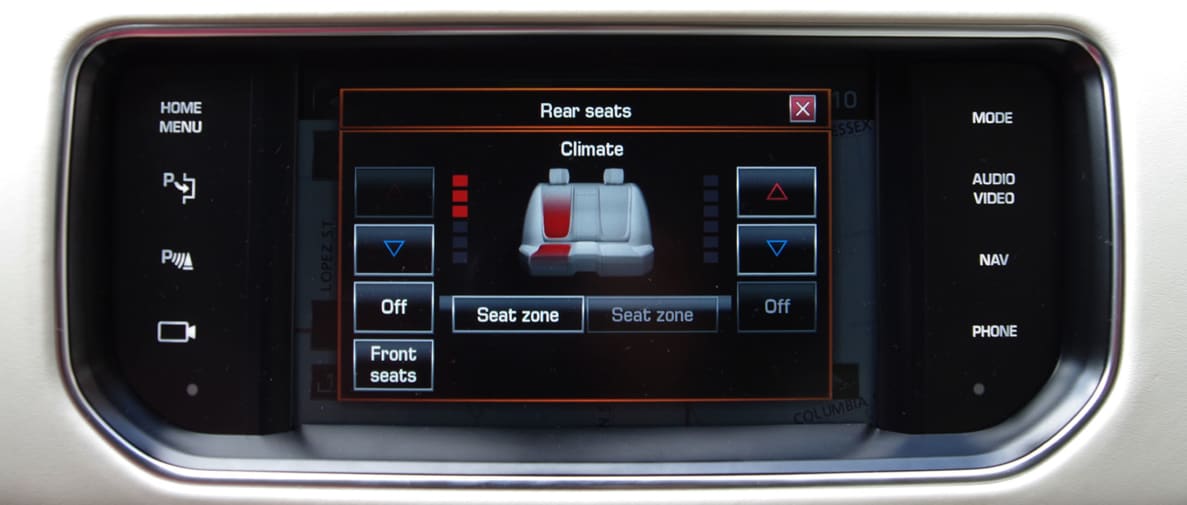I needed a driver.
See, the Long Wheelbase takes everything that's great about the current Range Rover and adds 7.8 inches, most of it dedicated to room for the rear passengers' legs.
Even with a 510-hp, 5.0-liter V8 under the hood, that makes the rear bench the best seat in the house.
{{ photo_gallery name="rear seats" }}
The model I drove even had a few upgrades back there: rear dual-zone climate controls, rear heated and cooled seats, and power lumbar plus recline/fold were part of the $4,150 Climate Comfort package, which also includes massaging front seats and a chilled compartment up front. The $2,400 Rear Seat Entertainment package added a remote control, two pairs of wireless headphones, and headrest-mounted screens. And the $600 Soft Door Close option automatically sucked in partially-shut doors, because the sound of a door slamming shut is so undignified.
My favorite option was the sublime 825-watt Meridian sound system. I admit that I created a special playlist just so I could use the Rover's voluminous passenger compartment as a personal listening room.
(It's also a testament to Land Rover's focus on quality control that even a turned up subwoofer couldn't unearth any errant buzzes or rattles. Compare that to a classic Range Rover County LWB from the '80s, whose headlights would flicker as soon as you popped in a cassette tape.)
{{ photo_gallery name="TECH" }}
Even with that impressive feature list, I'm sure you noticed a few omissions: There's no beverage chiller in the rear, and the seats don't offer leg rests. Worst of all, only the front seats offer a massage. What does a rear passenger have to spend to get a little luxury?
Well, step up to one of the 100 Autobiography models sold in the U.S., and those problems are solved. You'll also get exclusive color and finish treatments, full leather seating, and more interior lighting options. The Autobiography starts at $185,030.
Whichever variant you choose, driving the long wheelbase Rover is sure to be an unsettling experience—even if you aren't weaving through Moscow traffic with a temperamental oligarch in the backseat.

The Long Wheelbase Range Rover has been stretched by 7.8 inches. Most of it goes to the rear seats.
The first time I drove the LWB was at rush hour, where it defied all laws of physics, wending effortlessly through snarled city traffic. It was a busboy balancing a tray full of champagne flutes, and I-93 was the dining room at Le Cirque.
As soon as traffic let up, I put the throttle down. I have a vague memory of being snapped back into my seat, eyes wide open, the speedometer on the digital dash showing a number a lot higher than I expected.
I didn't have time to consider that the new Rover is built largely out of lightweight aluminum, that its V8 puts out 461 foot-pounds of torque, or that an adaptive air suspension keeps the whole thing headed in the right direction whether you're on- or off-road.
I did know that I had better back off quick—not because the car was becoming hard to handle, but because I didn't want to have to explain to a police officer that, yes, I knew why I'd been pulled over, and no, this wasn't my brand new Range Rover, and no, I didn't have a lawyer—what are those handcuffs for?
Even with its stretched chassis, the 5,137-pound Rover is capable of 0-60 mph in 5.5 seconds. 5,137 pounds, 5.5 seconds. Let that sink in a bit.
It's also good for 14 mpg city/19 highway. An auto start-stop function kills the massive engine at red lights, which helps cut emissions and improve fuel economy. That might sound like a token measure, but a big V8 wastes more fuel at idle than a smaller engine.
Of course, if someone else is driving you around, the only spec that matters is this Range Rover's 7.8 inches of additional legroom. From the back seat, all you'll notice is that someone is taking you where you need to go quickly, and in comfort.
Meet the tester
Keith was the Editor in Chief of Reviewed's appliance and automotive sites. His work has appeared in publications such as Wired, Car & Driver, and CityLab.
Checking our work.
Our team is here to help you buy the best stuff and love what you own. Our writers, editors, and experts obsess over the products we cover to make sure you're confident and satisfied. Have a different opinion about something we recommend? Email us and we'll compare notes.
Shoot us an email

